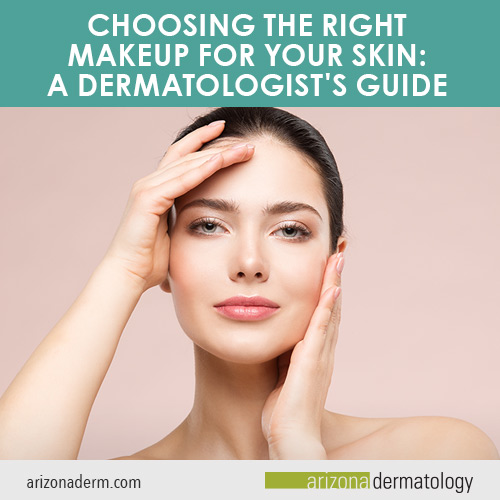 With Halloween on the horizon, October is the time of year we like to talk about makeup.
With Halloween on the horizon, October is the time of year we like to talk about makeup.
Makeup is a powerful tool for enhancing your natural beauty and boosting your confidence. However, not all makeup products are created equal, and the type of makeup you choose can impact your skin’s health. Let’s look at the different types of makeup and discuss which ones are better or worse for various skin types. Lastly, we’ll tell you when it’s time to replace your makeup to avoid bacteria buildup and potential skin issues.
Foundation
Foundation is the canvas upon which you build your makeup look, making it essential to choose the right one for your skin type. There are several foundation formulations to consider:
- Liquid Foundation: Liquid foundation is versatile and works well for most skin types. It provides buildable coverage, making it easy to achieve a natural or full-coverage look. Individuals with dry or mature skin may benefit from hydrating liquid foundations.
- Powder Foundation: Powder foundation is ideal for those with oily or acne-prone skin. It helps control shine and provides a matte finish. However, it may emphasize dry patches on dry skin.
- Cream Foundation: Cream foundations are perfect for individuals with dry or mature skin. They offer a creamy, hydrating texture that provides excellent coverage and a radiant finish.
- Mineral Foundation: Mineral foundation is generally suitable for all skin types, especially sensitive or acne-prone skin. It contains natural minerals and is free of harsh chemicals.
Primer
A makeup primer creates a smooth base for foundation and helps it adhere better, ensuring a longer-lasting finish. Primers also come in various formulations:
- Silicone-Based Primer: Silicone-based primers create a silky-smooth surface and help fill in fine lines and pores. They work well for most skin types but may not be suitable for those with silicone allergies.
- Water-Based Primer: Water-based primers are a better choice for sensitive or acne-prone skin. They are lightweight and won’t clog pores.
- Hydrating Primer: If you have dry or mature skin, opt for a hydrating primer. It provides an extra layer of moisture, helping your makeup look fresh all day.
Concealer
Concealers are essential for covering blemishes, dark circles, and imperfections. The type of concealer you choose should align with your skin type:
- Cream Concealer: Cream concealers are best for dry or mature skin. They offer a creamy consistency that blends easily and provides excellent coverage.
- Liquid Concealer: Liquid concealers work well for most skin types. They are lightweight and blend seamlessly, making them suitable for under-eye use.
- Stick Concealer: Stick concealers are convenient for touch-ups and spot coverage. They are versatile but may not be the best choice for those with dry skin, as they can be somewhat drying.
Blush and Bronzer
Blush and bronzer add dimension and color to your face. The type of product you choose can depend on your skin type:
- Powder Blush/Bronzer: Powder blush and bronzer work for most skin types. They offer buildable coverage and are easy to blend.
- Cream Blush/Bronzer: Cream blush and bronzer are great for dry or mature skin. They provide a natural, dewy finish and help maintain hydration.
- Liquid or Gel Blush: Liquid or gel blushes are suitable for all skin types. They provide a sheer, natural flush of color and can be layered for intensity.
Eyeshadow
Eyeshadows come in various formulations, each with its advantages:
- Powder Eyeshadow: Powder eyeshadows are the most common type and work well for all skin types. They are highly pigmented and offer various finishes, from matte to shimmer.
- Cream Eyeshadow: Cream eyeshadows are perfect for those with dry or mature skin, as they won’t settle into fine lines. They provide a smooth, long-lasting color.
- Liquid Eyeshadow: Liquid eyeshadows offer intense color payoff and are easy to apply. They are suitable for all skin types but may require more skill to blend.
Lipstick
Lipstick is the finishing touch to your makeup look. There are numerous lipstick formulations to choose from:
- Matte Lipstick: Matte lipsticks provide a velvety finish and are long-lasting. However, they can be drying, so individuals with dry lips should moisturize beforehand.
- Cream Lipstick: Cream lipsticks offer a creamy texture and hydrating properties. They work well for most skin types, especially those with dry or sensitive lips.
- Liquid Lipstick: Liquid lipsticks provide intense color and long wear. They may be drying, so it’s essential to prep the lips with a hydrating balm.
Dispose of Old Makeup at the Right Time
Makeup products can harbor bacteria over time, potentially leading to skin issues and infections. Replace old makeup regularly to ensure a healthy makeup routine. Here are some general guidelines to follow, although it should be mentioned that any makeup that begins to smell bad or which develops an odd look or consistency should be discarded. Sharing makeup and makeup brushes should also be avoided.
- Liquid foundations, concealers, and mascaras should be replaced every 3 to 6 months, as they have shorter shelf lives and are prone to bacterial growth.
- Powder-based products like eyeshadows, blushes, and bronzers can last longer, typically up to 2 years.
- Lipsticks and lip glosses can also last up to 2 years but should be discarded if they develop an off smell or change in texture.
- Makeup brushes and sponges should be cleaned regularly to avoid the accumulation of dirt and bacteria.
Staying vigilant about these guidelines will help ensure the safety and effectiveness of your makeup products while safeguarding your skin’s health.


